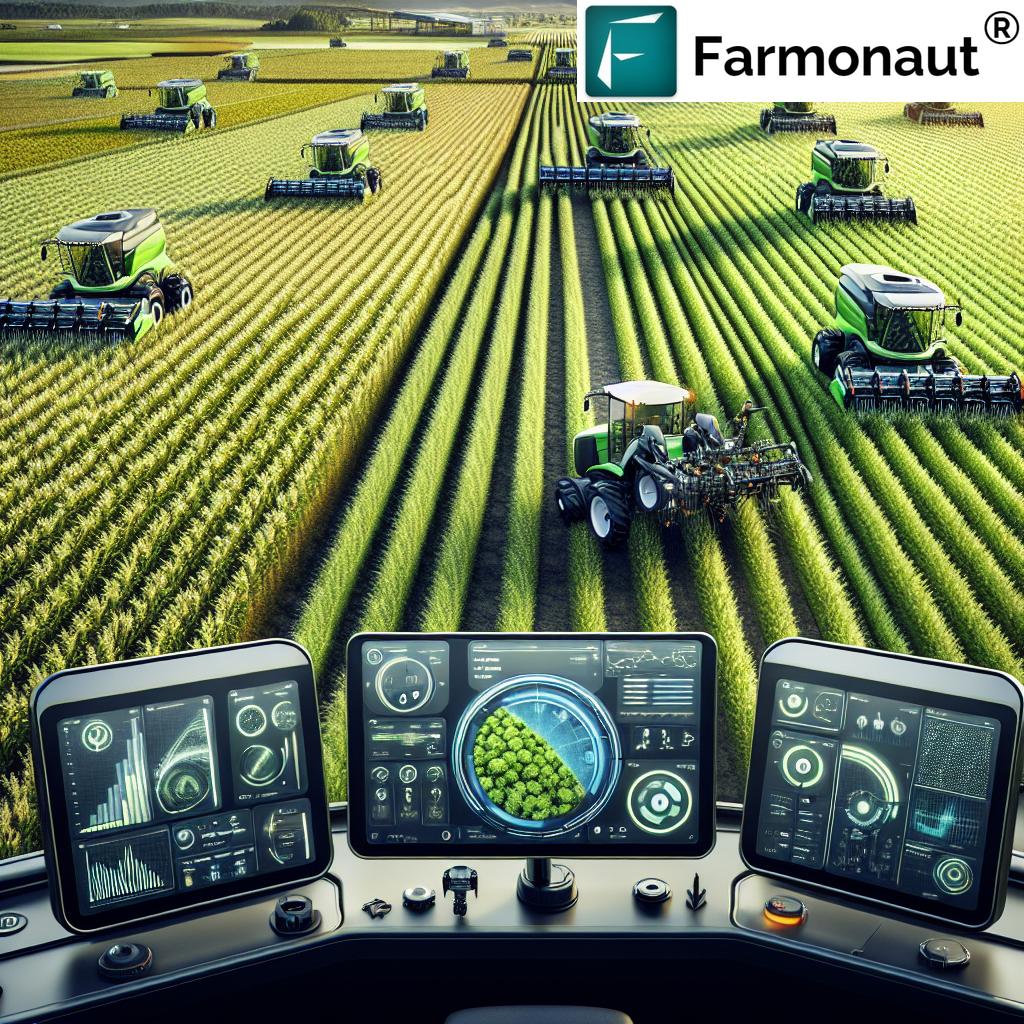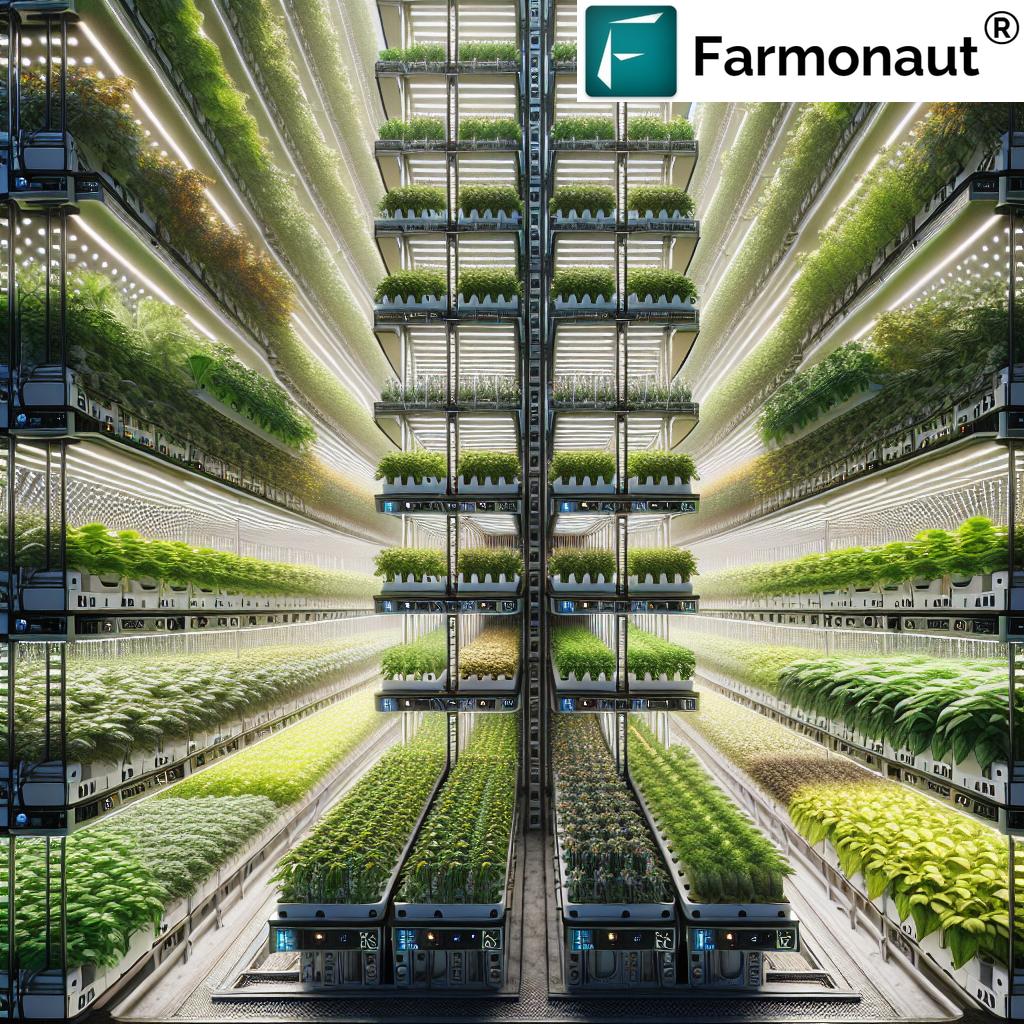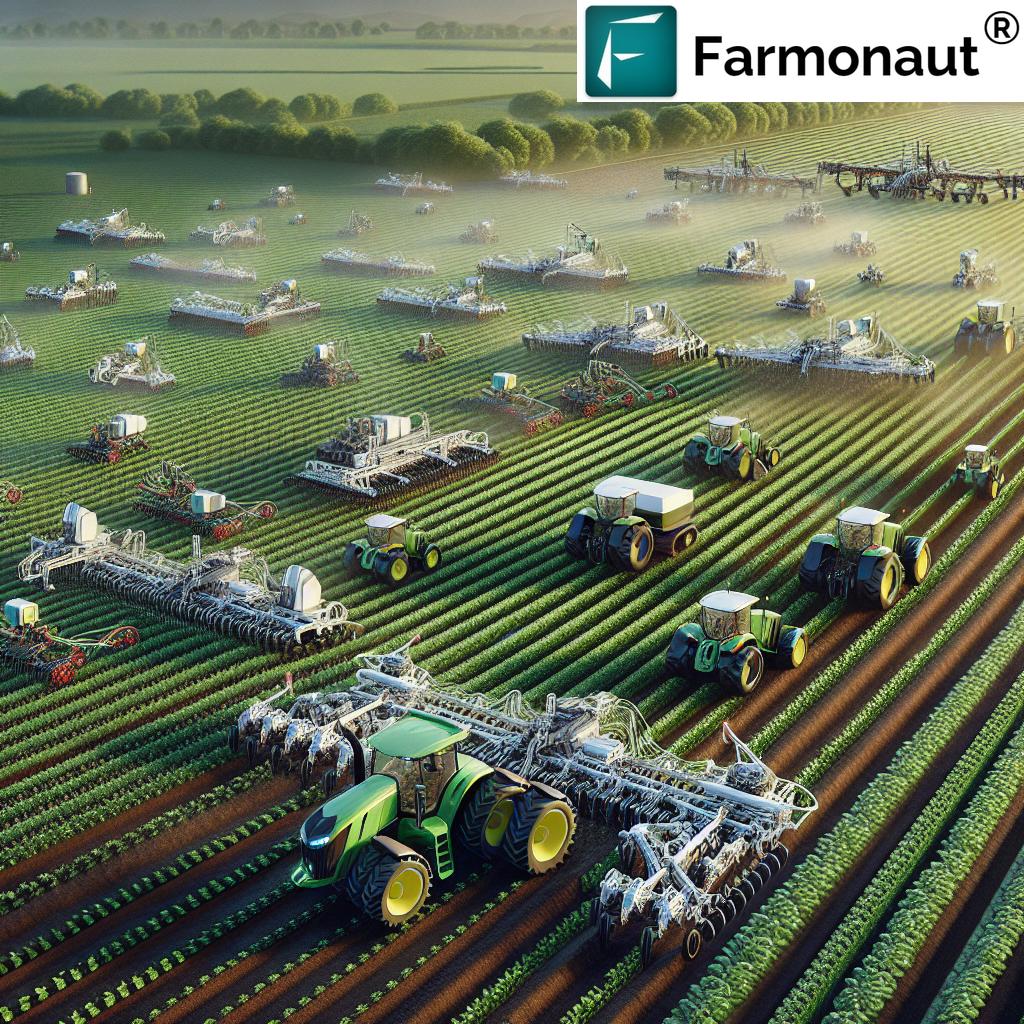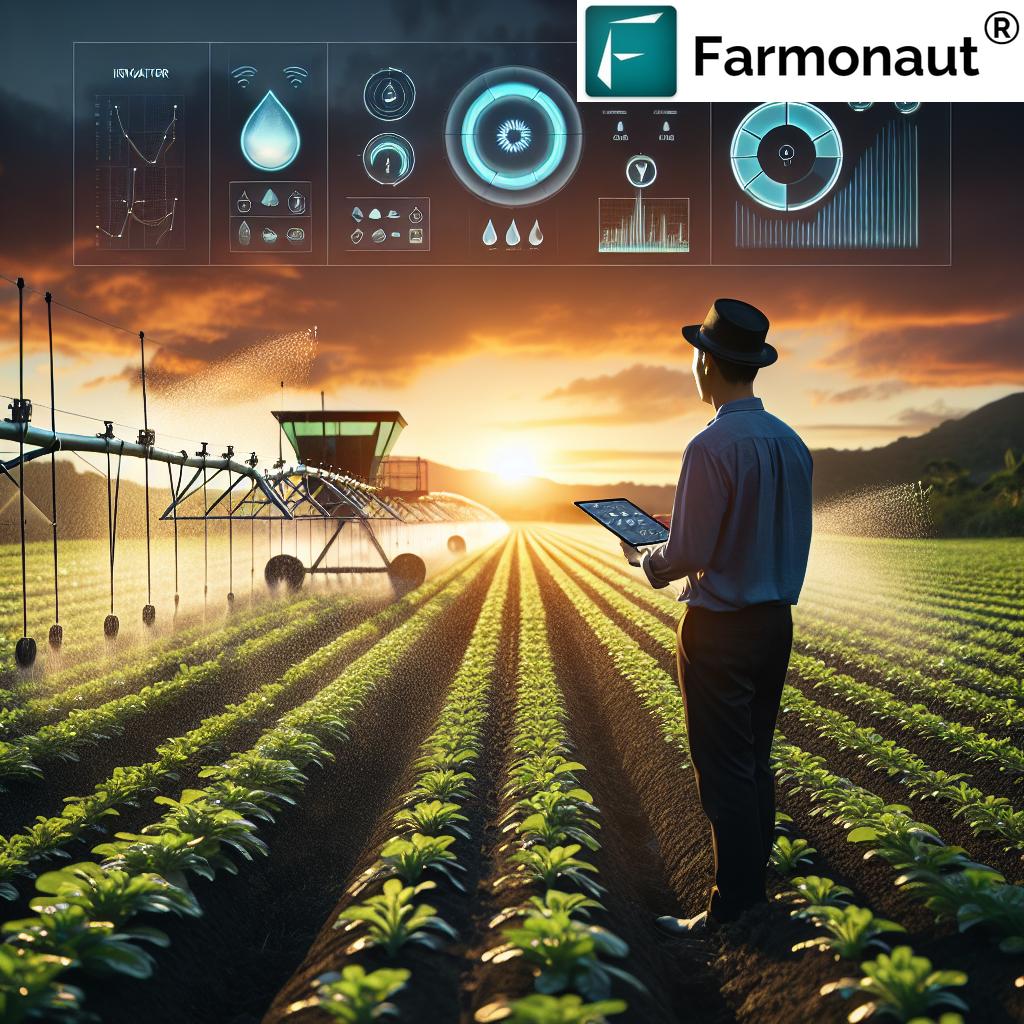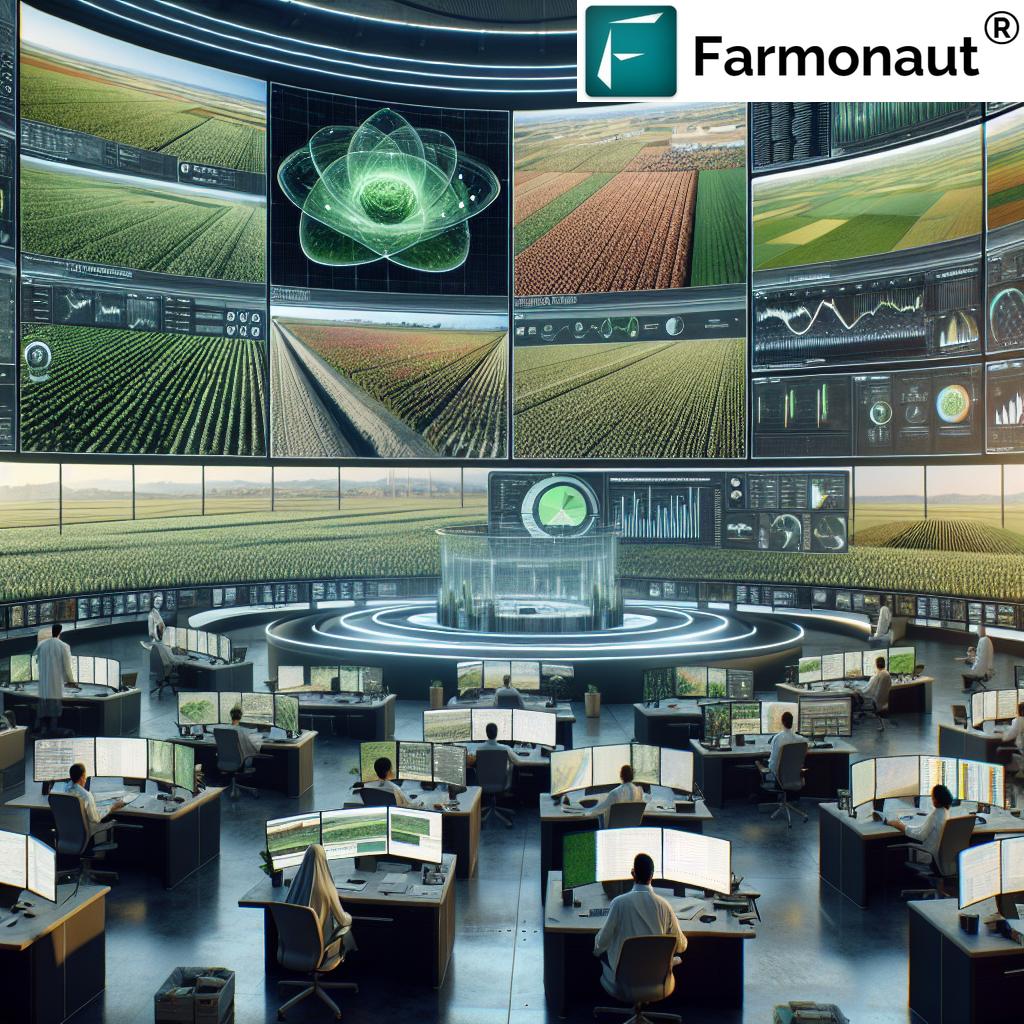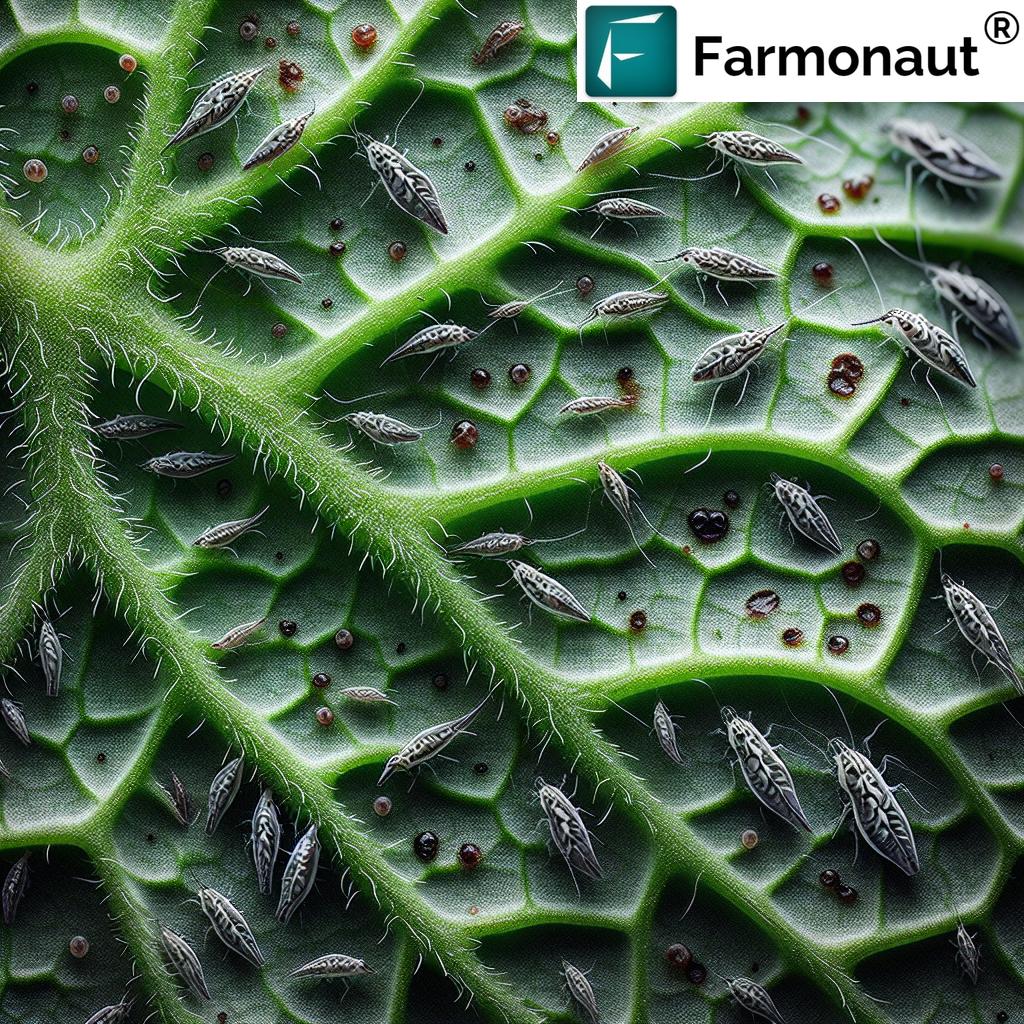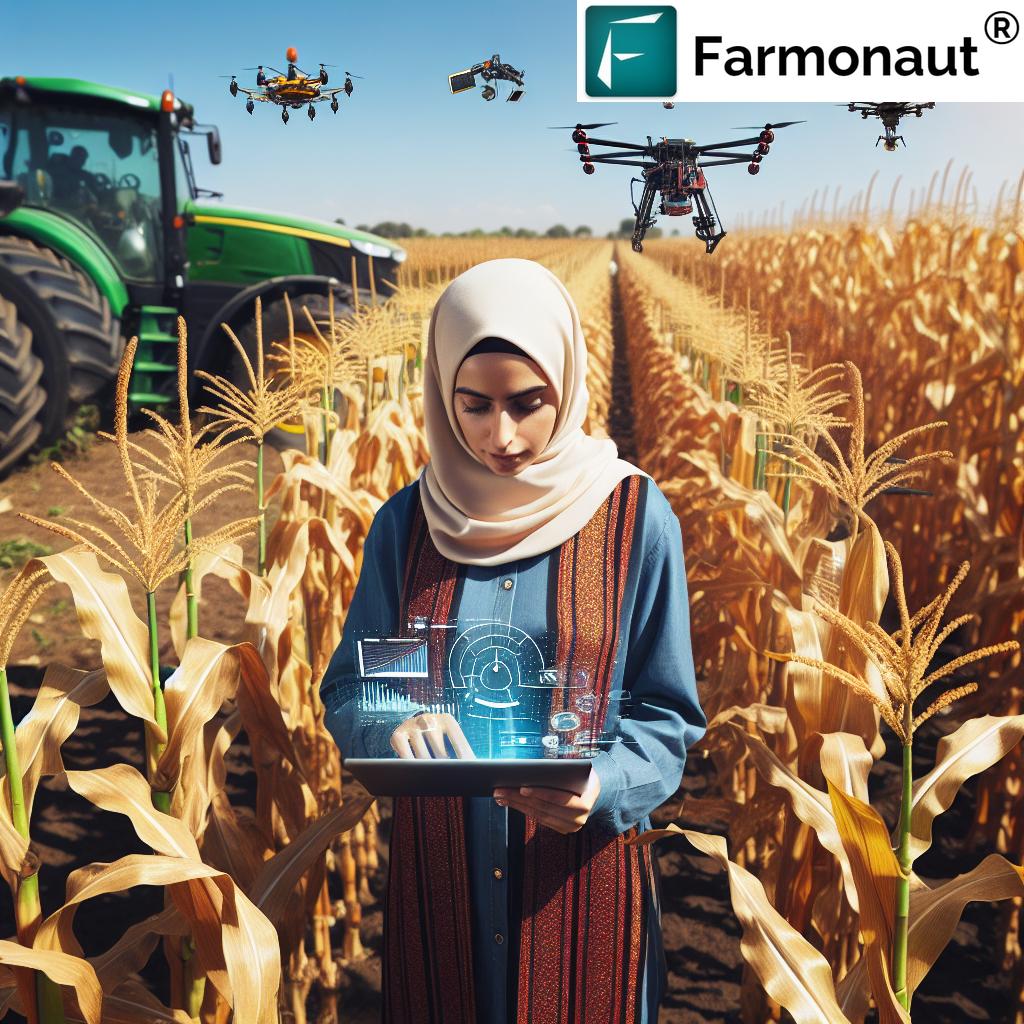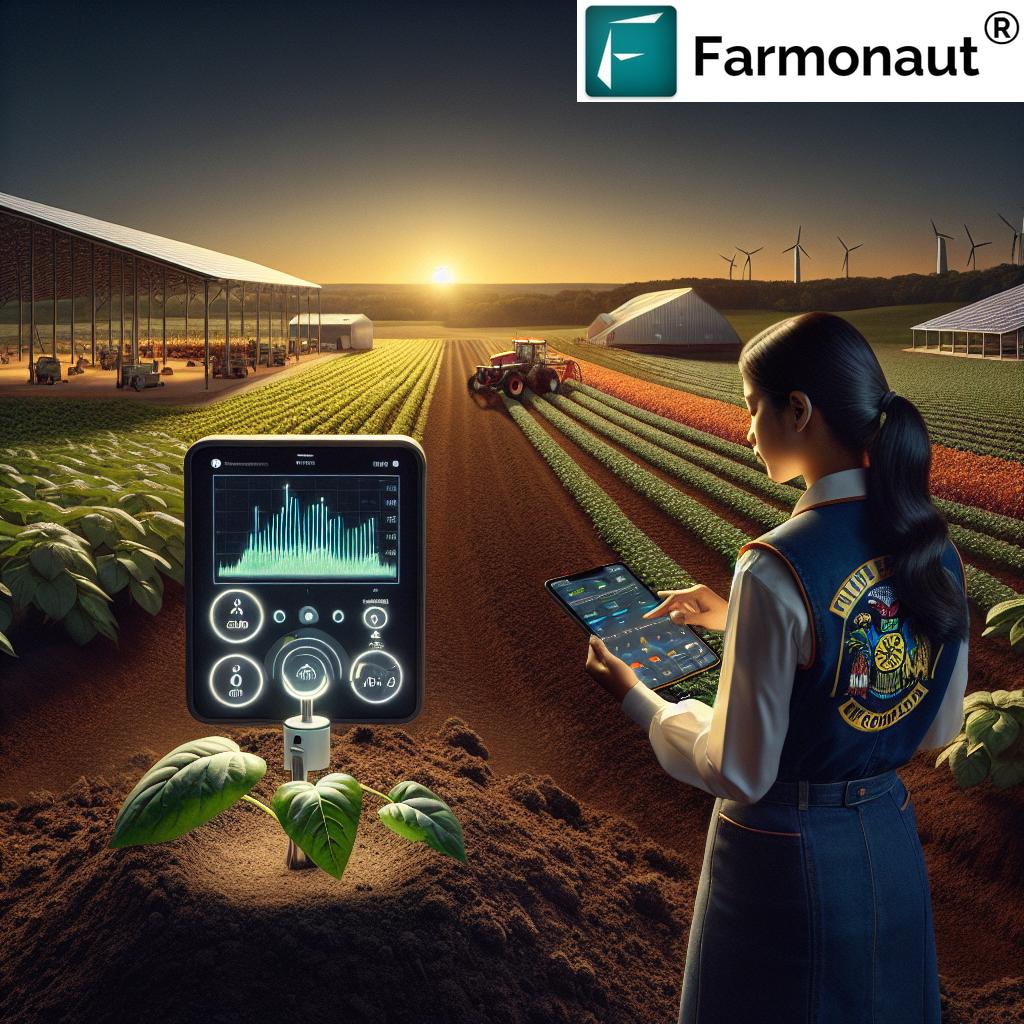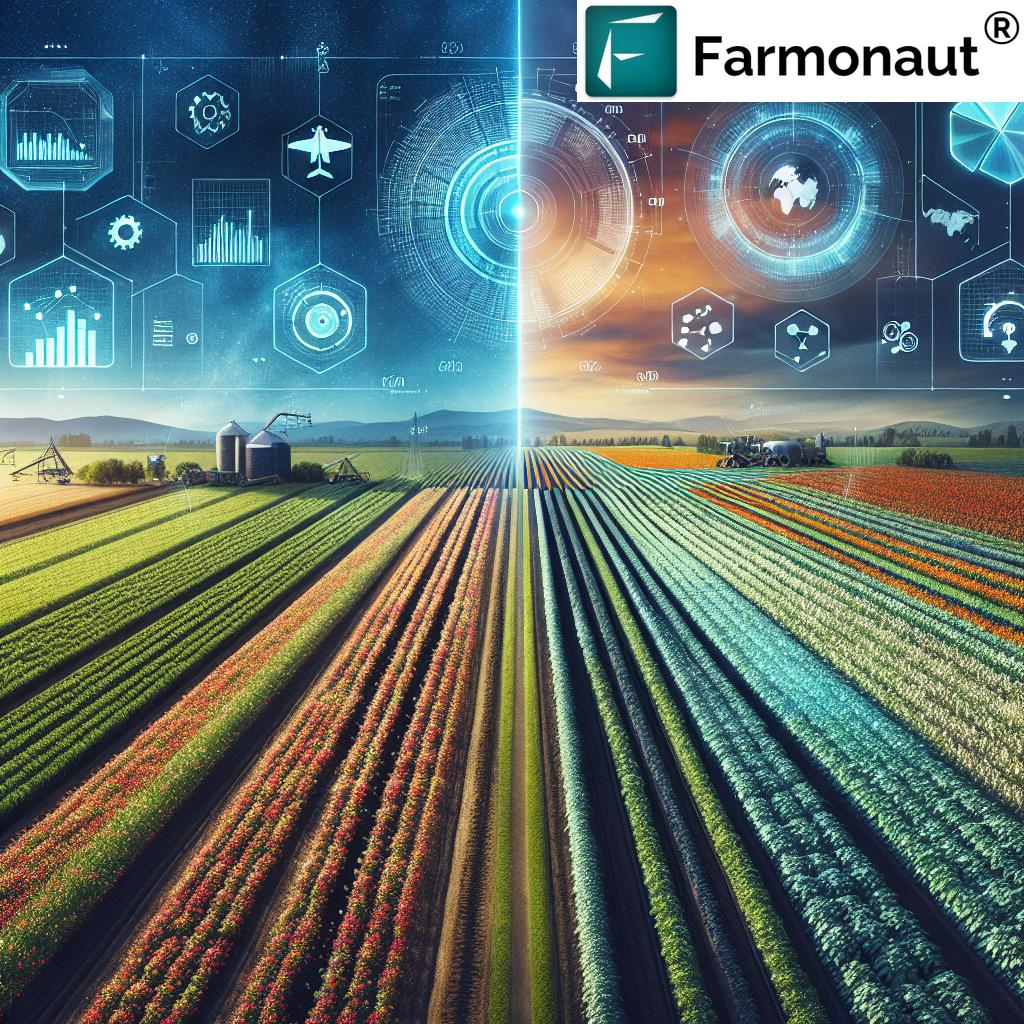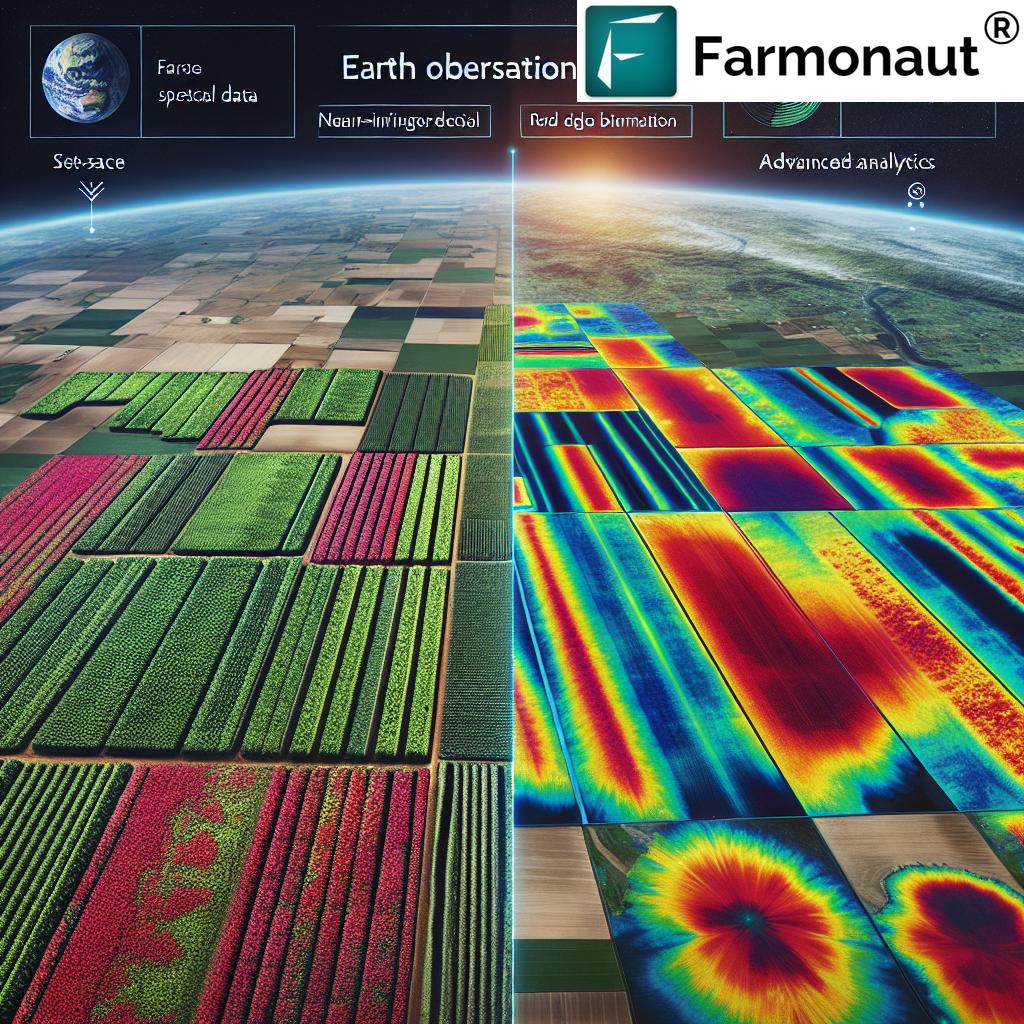Innovation in Agriculture Technology: 7 Shocking Trends!
“Precision agriculture can increase crop yields by up to 20% while reducing fertilizer use by 15%.”
Table of Contents
- Introduction: The Revolution in Agriculture Technology
- Trend 1: Automation and Robotics in Agriculture
- Trend 2: Data Analytics & Precision Agriculture
- Trend 3: Sustainable Practices and Environmental Impact
- Trend 4: Vertical Farming and Controlled-Environment Agriculture (CEA)
- Trend 5: Agrivoltaics—Dual-Use of Solar Energy and Agriculture
- Trend 6: Blockchain in Agriculture Supply Chain
- Trend 7: Nanotechnology in Agriculture
- The Role of Artificial Intelligence (AI) & Machine Learning
- Comparative Trends Table
- How Farmonaut Empowers This Revolution
- Addressing Agriculture Technology Challenges & Considerations
- Frequently Asked Questions (FAQ)
- Conclusion: Shaping the Future of Agriculture
Introduction: The Revolution in Agriculture Technology
Agriculture has stepped into a new era—one where technology, automation, and data are at the heart of producing, processing, and distributing the food that sustains us all. Innovation in agricultural technology is more than just introducing smart gadgets; it’s about revolutionizing the very foundation of how we grow and manage crops, optimize resources, and ensure sustainability.
With precision agriculture, robust data analytics in farming, sustainable farming practices, and automation in agriculture, we’re advancing toward a world where farming is not only more efficient but also kinder to our environment. In this comprehensive exploration, we’ll examine seven of the most shocking trends driving the next generation of agriculture, integrating core keywords such as automation, robotics, precision, analytics, environmental impact, and more.
Trend 1: Automation and Robotics in Agriculture
Let’s begin with a trend that’s transforming the daily lives of farmers: the integration of automation and robotics into farm operations. Automation in agriculture leverages autonomous machinery—think self-driving tractors, robotic harvesters, and even drone-based systems—to enhance precision and reduce labor costs.
How Automation Elevates Farming Efficiency
- Autonomous Tractors and Harvesters: These machines can plant, weed, and harvest with minimal human intervention, using computer vision and advanced AI to perform tasks exactly when and where they’re needed.
- Mechanical Weeders: Companies have developed automated weeders that use artificial intelligence to precisely remove weeds without chemicals, improving both efficiency and environmental health.
- Labor Shortages: Robotics help us address persistent labor shortages that challenge many agricultural sectors around the world, sustaining food production even as rural workforces decline.
For example, imagine a large midwestern farm where robotic harvesters traverse rows of crops, utilizing machine learning to distinguish crops from weeds, reducing the need for herbicides. This not only optimizes yields but also lowers environmental impact by minimizing chemical usage.
The impact? Lower operating costs, higher yields, and a more sustainable relationship with our land. Modern fleet management solutions can also integrate with these autonomous systems, ensuring machinery is used efficiently and safely.
Why does this matter? By embracing automation, we can enhance precision, reduce costs, and create a smarter, more sustainable food system.
Trend 2: Data Analytics & Precision Agriculture
The adoption of data analytics in farming is reshaping how we manage every stage of agriculture. Precision agriculture uses sensors, IoT devices, and real-time analytics to enable more informed, data-driven decisions.
Smart Farming: Sensors, IoT, and Big Data
- Soil & Crop Sensors: Monitor soil moisture, nutrient levels, and crop health, enabling targeted irrigation, fertilization, and pest control.
- Satellite Imagery: Advanced platforms—like those offered by Farmonaut—leverage multispectral satellite images to provide timely insights into crop vigor, disease presence, and more.
- Smart Irrigation Systems: Use weather data and soil sensors to deliver water only when and where it’s needed, conserving water and improving crop outcomes.
With data analytics in farming, we’re now able to optimize every dollar spent on inputs and minimize our environmental footprint. This approach leads to increased yields and dramatic reductions in water and fertilizer usage.
“Data-driven farming has helped cut water usage by nearly 30% in some technologically advanced agricultural regions.”
Curious about how you can get these benefits? Carbon footprint monitoring solutions allow you to track and reduce emissions across your farm operations for a more sustainable approach. Or consider Farmonaut’s large-scale farm management tools for streamlined crop analytics and reporting.
Farmonaut offers satellite-based crop health monitoring, soil moisture assessments, and real-time alerts on changing conditions, making precision agriculture affordable and accessible to all.
Trend 3: Sustainable Practices and Environmental Impact
Sustainable farming practices now take center stage as we work to reduce our environmental impact while boosting productivity. Through a blend of nature-based and data-driven solutions, we can cultivate stronger, healthier crops without exhausting our planet’s resources.
Key Sustainable Innovations
- Push–Pull Pest Management: Relies on intercropping strategies (using repellent “push” and trap “pull” plants) to control pests, reducing the need for chemical pesticides and enhancing soil and ecosystem health.
- Microbial Fertilizers: Harness beneficial microbes to boost nutrient uptake, decrease dependency on synthetic fertilizers, and cultivate more resilient soils.
- Water Conservation: Precision irrigation technologies, powered by IoT and satellite data, deliver water only as needed, directly contributing to both higher yields and environmental sustainability.
Farmonaut’s crop plantation and forestry advisory solutions align with these eco-friendly priorities, facilitating better land management, restoration projects, and sustainable production cycles.
Sustainable innovation is not optional—it’s vital to our collective future.
Trend 4: Vertical Farming and Controlled-Environment Agriculture (CEA)
Imagine growing lettuce, herbs, or strawberries in a vertical skyscraper instead of a sprawling field. Vertical farming and controlled-environment agriculture (CEA) allow us to produce more food in less space, using fewer resources, and completely independent of outdoor weather conditions.
Technology at Work in CEA
- Hydroponics & Aeroponics: Plants are grown in nutrient-enriched water or air, rather than in soil, reducing disease risk and maximizing yield per square meter.
- Advanced LED Lighting: Custom-tailored light wavelengths optimize photosynthesis and energy usage for indoor crops, independent of sunlight.
- Automated Climate Control: Computerized systems oversee humidity, CO2 concentration, light intensity, and nutrient levels for each growing area.
The benefits? Higher yields, shorter growth cycles, reduced pesticide use, and year-round production—even in urban or arid regions. Farmonaut’s farm management app is ideal for monitoring vertical farming assets, scheduling, and analyzing productivity.
Trend 5: Agrivoltaics—Dual-Use of Solar Energy and Agriculture
One of the most innovative sustainable trends is agrivoltaics, combining the production of solar energy and agriculture on the same land. Here, solar panels are strategically installed above crops—or even grazing pastures—simultaneously harvesting sunlight for electricity and crops for food.
- Crops & Solar Panels: Certain crops flourish under the shade of solar panels, which can reduce heat stress and water evaporation while still growing productively.
- Livestock Integration: Shaded “solar pastures” improve animal welfare and can extend productive grazing seasons.
- Dual Revenue Streams: Agrivoltaics unlocks opportunities for both renewable energy and agricultural income, increasing profitability and sustainability.
Studies show improved yields, lowered temperatures, and a significant reduction in water usage—key for “climate-smart agriculture.” When combined with carbon footprint tracking provided by Farmonaut, farmers can demonstrate and enhance their climate-conscious operations.
Trend 6: Blockchain in Agriculture Supply Chain
Blockchain technology is revolutionizing transparency and traceability in agriculture supply chains. By providing an immutable record at every stage—from planting to retail shelf—we’re now able to verify food origins, quality, and safety.
Blockchain: The Foundation of Trust and Traceability
- Food Authenticity: Blockchain makes it easy for consumers to trace the journey of their food, from farm to plate, ensuring safety and fair compensation for farmers.
- Supply Chain Efficiency: Faster and more accurate product recalls in the event of contamination, minimizing waste and boosting public confidence.
- Secured Transactions: Reduces fraud and enables timely, verifiable payments to all agriculture supply chain participants.
Farmonaut provides blockchain-based traceability solutions for agriculture and various industries, promoting supply chain transparency and strengthening consumer trust.
Learn more about integrating satellite data and blockchain with Farmonaut’s API for agritech developers or access the interactive API Developer Docs here.
Trend 7: Nanotechnology in Agriculture
Nanotechnology is breaking new ground in sustainable farming practices. By engineering materials at the nanoscale, we gain powerful tools for increasing nutrient efficiency, enhancing crop health, and reducing the need for chemical inputs.
Nanotechnology Innovations that Reshape Farming
- Nanofertilizers: Vastly improve the delivery and absorption of nutrients, reducing fertilizer use and runoff into waterways.
- Nanopesticides: Target pests with unprecedented precision, often using slower-release mechanisms for sustainable, long-term pest management with less environmental side-effect.
- Nanosensors: Early detection of soil issues, plant diseases, and even toxic residues, allowing for rapid, data-driven intervention and minimizing crop losses.
Integrating nanotechnology makes precision agriculture even more impactful—improving nutrient management, reducing resource usage, and safeguarding our environment for future generations.
The Role of Artificial Intelligence (AI) & Machine Learning in Agriculture Technology Innovations
Artificial intelligence (AI) and machine learning are at the core of many agricultural technology innovations. By processing gigantic amounts of data, AI enables predictive analytics, smarter resource allocation, and breeding of climate-resilient crops.
- Climate-Smart Agriculture: AI-driven predictions enable us to adapt to and mitigate the effects of climate change—such as extreme weather events—on farming.
- Crop Breeding: Machine learning analyzes thousands of genetic data points to breed crops that withstand drought, pests, and disease.
- Resource Optimization: AI software guides farmers on precisely when to irrigate, fertilize, or intervene for maximum efficiency, yield, and environmental health.
Farmonaut’s AI-based advisory system delivers personalized, satellite-driven advice and weather forecasts—empowering farmers globally to make more informed decisions.
For those seeking financial support, crop loan and insurance verification via satellite can speed up access to funds and minimize lending risks for both farmers and financial institutions.
Comparative Trends Table: The Impact of 7 Key Innovations
| Trend / Technology | Key Features | Est. Yield Improvement (%) | Est. Cost Reduction (%) | Environmental Impact |
|---|---|---|---|---|
| Precision Agriculture & Data Analytics |
|
10% – 20% | 10% – 30% | Reduces water & fertilizer use, limits runoff |
| Automation & Robotics |
|
7% – 15% | 15% – 25% | Cuts chemical inputs, lowers emissions |
| Sustainable Practices |
|
5% – 10% | 8% – 14% | Improves soil health, promotes biodiversity |
| Vertical Farming & CEA |
|
25% – 35% | 10% – 20% | Reduces land, water, & pesticide needs |
| Agrivoltaics |
|
5% – 10% | 5% – 18% | Lowers water needs, reduces land competition |
| Blockchain |
|
2% – 6% | 2% – 10% | Reduces waste, cuts fraud & improves safety |
| Nanotechnology |
|
8% – 18% | 6% – 12% | Minimizes chemical input & pollution |
How Farmonaut Empowers This Revolution
As a global leader in agricultural technology, Farmonaut is dedicated to democratizing precision agriculture. By making advanced satellite-based analytics, AI-driven advisory, and blockchain-enabled traceability accessible through intuitive web and mobile apps, Farmonaut empowers farmers, agribusinesses, governments, and corporates to embrace these game-changing trends.
Farmonaut’s Core Offerings at a Glance:
- Satellite-Based Crop Health Monitoring: Real-time crop health and soil moisture insights, directly to your device.
- AI-Powered Jeevn Advisory: Personalized strategies, weather forecasts, and resource tips for optimized yields and reduced input costs.
- Blockchain Traceability: End-to-end supply chain transparency for trustworthy and efficient transactions—see more about traceability.
- Carbon Footprint Tracking: Monitor and minimize your environmental impact—vital for “climate-smart agriculture.”
- Fleet & Resource Management: Track and manage all your farm equipment efficiently—see our fleet management solution for details.
- API Access and Integrations: Flexible API (see API here and API Developer Docs) for custom platforms, agritech apps, and enterprise integration.
Accessible via app and web browser, Farmonaut’s subscription packages are affordable and scalable for every type of user—from smallholder farmers to governments and corporates.
Addressing Agriculture Technology Challenges & Considerations
While these advancements promise a sustainable food future, there are hurdles on the road to full adoption:
- Initial Costs: The upfront investment for advanced systems can challenge smaller farming operations. Farmonaut addresses this with subscription-based, scalable pricing models.
- Data Privacy & Security: The influx of data must be protected; blockchain and secured platforms help mitigate risks.
- Labor Concerns: Automation may shift labor requirements, necessitating new training and technical support for the workforce.
- Access & Training: Ensuring farmers worldwide have equitable access and technical guidance remains essential.
- Scalability: Technology must be adaptable for both smallholder farms and expansive agribusinesses.
With the right mix of technology, support, and sustainable practices, the future of agriculture will be more efficient, eco-friendly, and resilient than ever before.
Frequently Asked Questions (FAQ)
What is precision agriculture and how does it help farmers?
Precision agriculture leverages advanced data analytics, sensors, and satellite imagery to help farmers monitor their fields in real time. This approach allows for targeted use of water, fertilizer, and pesticides—maximizing efficiency, yields, and sustainability.
How does data analytics improve farming efficiency?
Data analytics transforms large amounts of farm data into actionable insights. This helps optimize irrigation, forecast weather effects, monitor crop health, and allocate resources precisely—improving both productivity and environmental health.
Can small farms access advanced agricultural technologies?
Yes! Farmonaut’s affordable satellite-based platform is specifically designed to make precision agriculture accessible and budget-friendly for small and medium-sized farms via subscriptions, Android/iOS apps, and APIs.
What environmental benefits do sustainable farming practices provide?
Sustainable practices improve soil health, reduce chemical and water usage, promote biodiversity, and help mitigate climate change impacts—ensuring that our food systems remain resilient for generations to come.
What is the role of blockchain in agriculture?
Blockchain technology brings transparency and traceability to agriculture supply chains. This not only helps consumers verify the origins and safety of their food but also ensures fair compensation across the supply chain and facilitates efficient product recalls.
Does Farmonaut offer solutions for agricultural carbon footprint tracking?
Absolutely! Farmonaut’s carbon footprint tracking tool helps farmers and agribusinesses monitor, report, and reduce energy use and emissions—key for “climate-smart agriculture.”
How do I access Farmonaut’s services?
You can access services via web and mobile apps, subscribe to advanced plans, or use Farmonaut APIs for enterprise and research purposes.
Conclusion: Shaping the Future of Agriculture
Innovation in agricultural technology is driving unprecedented change—not only making farming more efficient and productive, but also directly addressing our most urgent environmental and resource challenges. From the integration of automation and robotics, to climate-smart precision agriculture, to the transparency of blockchain-based supply chain solutions and the promise of nanotechnology in agriculture, the future is being built by those who adapt to and embrace new technologies.
As we continue this transformation, the mission is clear: feed a growing global population responsibly, affordably, and sustainably. Companies like Farmonaut are leading the way—bringing cutting-edge innovations to farmers’s fingertips, ensuring that yield, efficiency, and sustainability are not mutually exclusive but reinforcing pillars of a thriving future for agriculture.
By adopting these advances and championing sustainable farming practices, we each play a part in reshaping how food is produced, processed, and distributed worldwide.
Start your journey with Farmonaut—building a smarter, greener, and more resilient agriculture sector, today!





